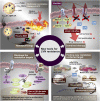Lenvatinib resistance mechanism and potential ways to conquer
- PMID: 37153782
- PMCID: PMC10157404
- DOI: 10.3389/fphar.2023.1153991
Lenvatinib resistance mechanism and potential ways to conquer
Abstract
Lenvatinib (LVN) has been appoved to treat advanced renal cell carcinoma, differentiated thyroid carcinoma, hepatocellular carcinoma. Further other cancer types also have been tried in pre-clinic and clinic without approvation by FDA. The extensive use of lenvastinib in clinical practice is sufficient to illustrate its important therapeutic role. Although the drug resistance has not arised largely in clinical, the studies focusing on the resistance of LVN increasingly. In order to keep up with the latest progress of resistance caused by LVN, we summerized the latest studies from identify published reports. In this review, we found the latest report about resistance caused by lenvatinib, which were contained the hotspot mechanism such as the epithelial-mesenchymal transition, ferroptosis, RNA modification and so on. The potential ways to conquer the resistance of LVN were embraced by nanotechnology, CRISPR technology and traditional combined strategy. The latest literature review of LVN caused resistance would bring some ways for further study of LVN. We call for more attention to the pharmacological parameters of LVN in clinic, which was rarely and would supply key elements for drug itself in human beings and help to find the resistance target or idea for further study.
Keywords: Lenvatinib; drug resistance; hepatocellular carcinoma; mechanism; pharmacological parameters.
Copyright © 2023 Bo and Chen.
Conflict of interest statement
The authors declare that the research was conducted in the absence of any commercial or financial relationships that could be construed as a potential conflict of interest.
Figures





Similar articles
-
Genome-Wide CRISPR/Cas9 Library Screening Identified that DUSP4 Deficiency Induces Lenvatinib Resistance in Hepatocellular Carcinoma.Int J Biol Sci. 2022 Jul 4;18(11):4357-4371. doi: 10.7150/ijbs.69969. eCollection 2022. Int J Biol Sci. 2022. PMID: 35864956 Free PMC article.
-
Activation of the HGF/c-MET axis promotes lenvatinib resistance in hepatocellular carcinoma cells with high c-MET expression.Med Oncol. 2020 Mar 12;37(4):24. doi: 10.1007/s12032-020-01350-4. Med Oncol. 2020. PMID: 32166604
-
METTL3-m6A-EGFR-axis drives lenvatinib resistance in hepatocellular carcinoma.Cancer Lett. 2023 Apr 10;559:216122. doi: 10.1016/j.canlet.2023.216122. Epub 2023 Mar 9. Cancer Lett. 2023. PMID: 36898427
-
Resistance of Lenvatinib in Hepatocellular Carcinoma.Curr Cancer Drug Targets. 2022;22(11):865-878. doi: 10.2174/1568009622666220428111327. Curr Cancer Drug Targets. 2022. PMID: 36267045 Review.
-
Genome-scale CRISPR-Cas9 knockout screening in hepatocellular carcinoma with lenvatinib resistance.Cell Death Discov. 2021 Nov 18;7(1):359. doi: 10.1038/s41420-021-00747-y. Cell Death Discov. 2021. PMID: 34795217 Free PMC article. Review.
Cited by
-
Improving the response to lenvatinib in partial responders using a Constrained-Disorder-Principle-based second-generation artificial intelligence-therapeutic regimen: a proof-of-concept open-labeled clinical trial.Front Oncol. 2024 Jul 30;14:1426426. doi: 10.3389/fonc.2024.1426426. eCollection 2024. Front Oncol. 2024. PMID: 39139285 Free PMC article.
-
Small-molecule-based targeted therapy in liver cancer.Mol Ther. 2024 Oct 2;32(10):3260-3287. doi: 10.1016/j.ymthe.2024.08.001. Epub 2024 Aug 8. Mol Ther. 2024. PMID: 39113358 Review.
-
Strategies and Recent Advances on Improving Efficient Antitumor of Lenvatinib Based on Nanoparticle Delivery System.Int J Nanomedicine. 2024 Jun 10;19:5581-5603. doi: 10.2147/IJN.S460844. eCollection 2024. Int J Nanomedicine. 2024. PMID: 38882543 Free PMC article. Review.
-
Impact of Type of Lenvatinib Resistance on Prognosis and Second-Line Regimen in Patients with Virus-Associated HCC.J Hepatocell Carcinoma. 2024 Aug 8;11:1507-1517. doi: 10.2147/JHC.S476439. eCollection 2024. J Hepatocell Carcinoma. 2024. PMID: 39135736 Free PMC article.
-
Role of APE1 in hepatocellular carcinoma and its prospects as a target in clinical settings (Review).Mol Clin Oncol. 2024 Sep 6;21(5):82. doi: 10.3892/mco.2024.2780. eCollection 2024 Nov. Mol Clin Oncol. 2024. PMID: 39301126 Free PMC article. Review.
References
-
- Ao J., Chiba T., Shibata S., Kurosugi A., Qiang N., Ma Y., et al. (2021). Acquisition of mesenchymal-like phenotypes and overproduction of angiogenic factors in lenvatinib-resistant hepatocellular carcinoma cells. Biochem. Biophys. Res. Commun. 549, 171–178. 10.1016/j.bbrc.2021.02.097 - DOI - PubMed
Publication types
Grants and funding
LinkOut - more resources
Full Text Sources
Miscellaneous

